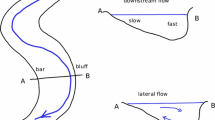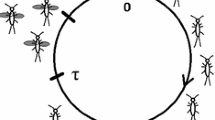Abstract
The drift paradox asks how stream-dwelling organisms can persist, without being washed out, when they are continuously subject to the unidirectional stream flow. To date, mathematical analyses of the stream paradox have investigated the interplay of growth, drift and flow needed for species persistence under the assumption that the stream environment is temporally constant. However, in reality, streams are subject to major seasonal variations in environmental factors that govern population growth and dispersal. We consider the influence of such seasonal variations on the drift paradox, using a time-periodic integrodifferential equation model. We establish upstream and downstream spreading speeds under the assumption of periodically fluctuating environments, and also show the existence of periodic traveling waves. The sign of the upstream spreading speed then determines persistence. Fluctuating environments are characterized by seasonal correlations between the flow, transfer rates, diffusion and settling rates, and we investigate the effect of such correlations on the population spread and persistence. We also show how results in this paper can formally connect to those for autonomous integrodifferential equations, through the appropriate weighted averaging methods. Finally, for a specific dispersal function, we show that the upstream spreading speed is nonnegative if and only if the critical domain size exists in this temporally fluctuating environment.
Similar content being viewed by others
References
Allan JD (1995) Stream ecology structure and function of running waters. Chapman & Hall, London
Anderson KE, Nisbet RM, Diehl S, Cooper SD (2005) Scaling population responses to spatial environmental variability in advection-dominated systems. Ecol Lett 8: 933–943
Aronson DG, Weinberger HF (1975) Nonlinear diffusion in population genetics, combustion, and nerve pulse propagation. In: Goldstein JA (eds) Partial differential equations and related topics. Lecture notes in Mathematics, vol 446. Springer, Berlin, pp 5–49
Diehl S, Anderson K, Nisbet RM (2008) Population responses of drifting stream invertebrates to spatial environmental variability: an emerging conceptual framework. In: Lancaster J, Briers R (eds) Aquatic insects: challenges to populations
Elliott JM (2002) Time spent in the drift by downstream-dispersing invertebrates in a Lake District stream. Freshw Biol 47: 97–106
Humpesch UH (1979) Life cycles and growth rates of Baetis spp. (Ephemeroptera: Baetidae) in the laboratory and in two stony streams in Austria. Freshw Biol 9: 467–479
Hutson V, Martinez S, Mischaikow K, Vickers GT (2003) The evolution of dispersal. J Math Biol 47: 483–517
Jin Y, Lewis MA (2011) Seasonal influences on population spread and persistence in streams: critical domain size. SIAM J Appl Math 71(4): 1241–1262
Jin Y, Zhao X-Q (2009) Spatial dynamics of a periodic population model with dispersal. Nonlinearity 22: 1167–1189
Kevorkian J, Cole JD (1996) Multiple scale and singular perturbation methods. Springer, New York
Kot M, Schaffer WM (1986) Discrete-time growth-dispersal models. Math Biosci 80: 109–136
Kot M, Lewis MA, van den Driesche P (1996) Dispersal data and the spread of invading organisms. Ecology 77: 2027–2042
Liang X, Zhao X-Q (2007) Asymptotic speeds of spread and traveling waves for monotone semiflows with applications. Commun Pure Appl Math 60: 1–40 Erratum 61:137–138 (2008)
Liang X, Yi Y, Zhao X-Q (2006) Spreading speeds and traveling waves for periodic evolution systems. J Differ Equ 231: 57–77
Lockwood D, Hastings A, Botsford L (2002) The effects of dispersal patterns on marine reserve: does the tail wag the dog?. Theoret Popul Biol 61: 297–309
Lou Y, Zhao X-Q (2010) The periodic Ross-Macdonald model with diffusion and advection. Appl Anal 89: 1067–1089
Lutscher F, Pachepsky E, Lewis MA (2005) The effect of dispersal patterns on stream populations. SIAM Rev 47: 749–772
Lutscher F, Lewis MA, McCauley E (2006) Effects of heterogeneity on spread and persistence in rivers. Bull Math Biol 68: 2129–2160
Lutscher F, Nisbet RM, Pachepsky E (2010) Population persistence in the face of advection. Theor Ecol 3: 271–284
Müller K (1954) Investigations on the organic drift in North Swedish streams. Tech report 34, Institute of Freshwater Research, Drottningholm, Sweden
Müller K (1982) The colonization cycle of freshwater insects. Oecologica 53: 202–207
Othmer H, Dunbar S, Alt W (1988) Models of dispersal in biological systems. J Math Biol 26: 263–298
Pachepsky E, Lutscher F, Nisbet R, Lewis MA (2005) Persistence, spread and the drift paradox. Theoret Popul Biol 67: 61–73
Speirs DC, Gurney WSC (2001) Population persistence in rivers and estuaries. Ecology 82: 1219–1237
Turchin P (1998) Quantitative analysis of movement. Sinauer, Sunderland
Van Kirk RW, Lewis MA (1997) Integrodifference models for persistence in fragmented habitats. Bull Math Biol 59: 107–137
Waters TF (1965) Interpretation of invertebrate drift in streams. Ecology 46: 327–334
Weinberger HF (1982) Long-time behavior of a class of biological models. SIAM J Math Anal 13: 353–396
Weinberger HF, Zhao X-Q (2010) An extension of the formula for spreading speeds. Math Biosci Eng 7: 187–194
Weiss GH (1994) A primer of random walkology. In: Bunde A, Havlin S (eds) Fractals in science. Springer, Berlin, pp 119–161
Yagisita H (2009) Existence and nonexistence of traveling waves for a nonlocal monostable equation. Publ RIMS Kyoto Univ 45: 925–953
Author information
Authors and Affiliations
Corresponding author
Additional information
Supported by MITACS Network for Biological Invasions and Dispersal, National Sciences and Engineering Research Council of Canada, Sustainable Resource Development Alberta, Alberta Water Research Institute, and a Canada Research Chair in Mathematical Biology (MAL).
Rights and permissions
About this article
Cite this article
Jin, Y., Lewis, M.A. Seasonal influences on population spread and persistence in streams: spreading speeds. J. Math. Biol. 65, 403–439 (2012). https://doi.org/10.1007/s00285-011-0465-x
Received:
Revised:
Published:
Issue Date:
DOI: https://doi.org/10.1007/s00285-011-0465-x




